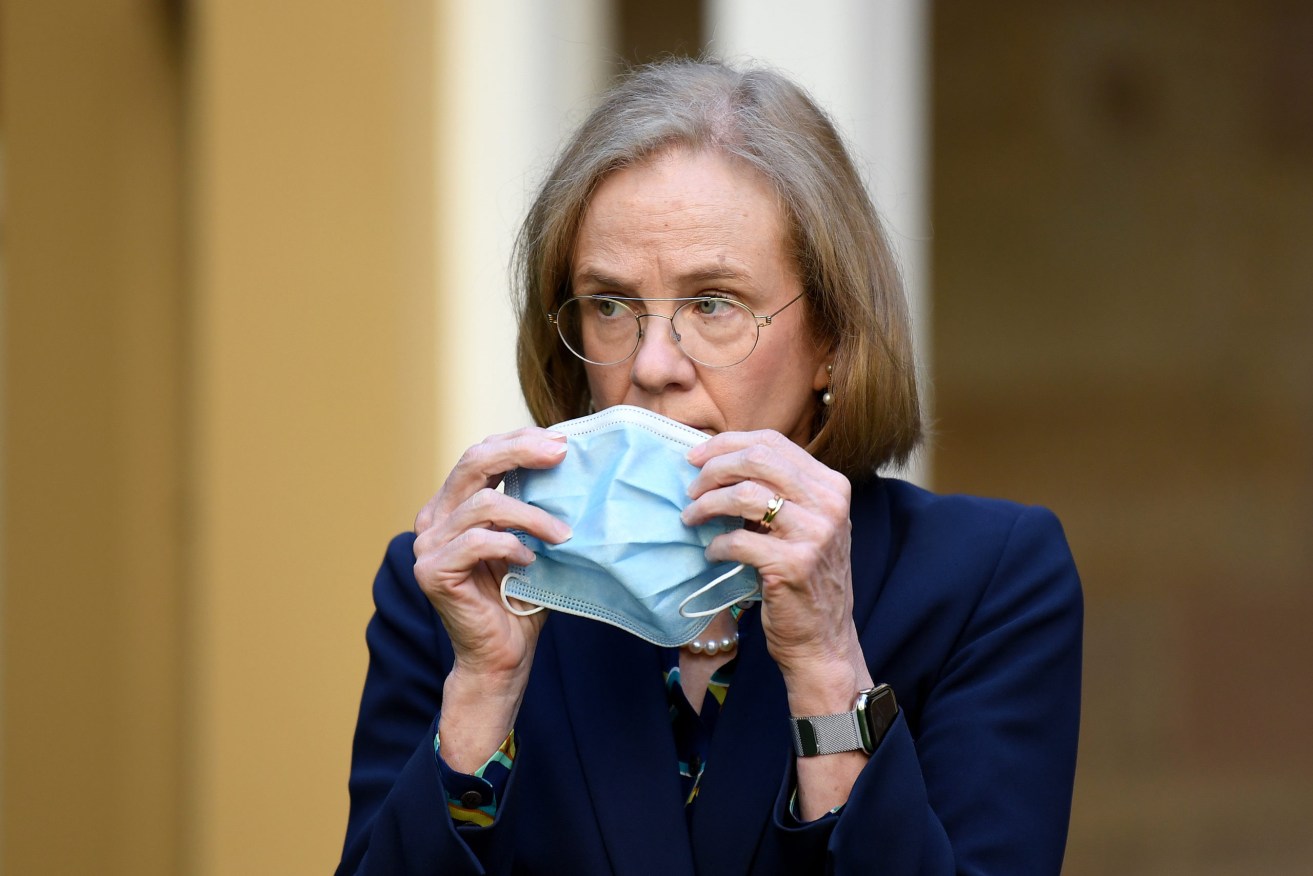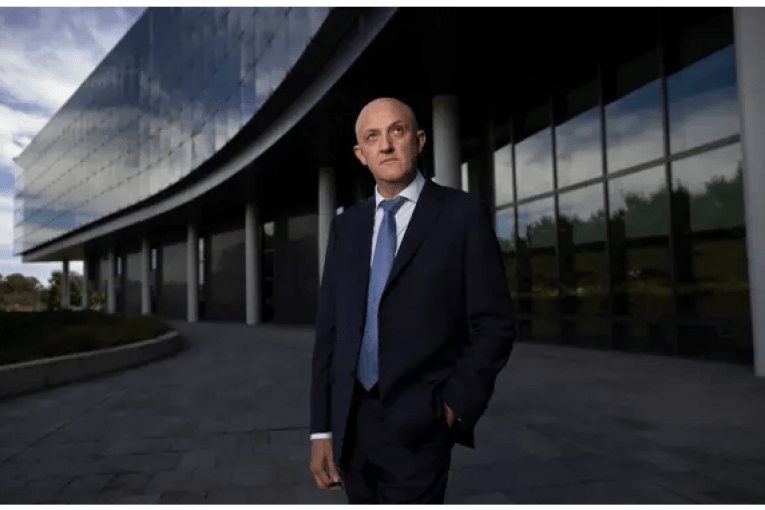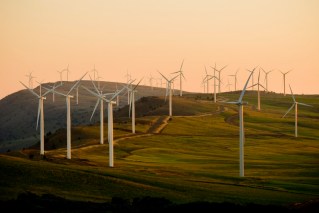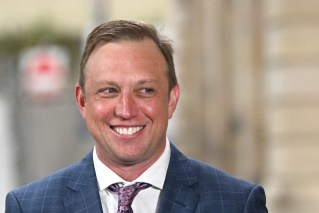Brought undone by deadly Delta, or did Queensland finally just run out of luck?
Chief Health Officer Jeannette Young was, over summer, confident Queensland would no longer need lockdowns. This winter, the state is entering its darkest period yet, as Sean Parnell writes.

Queensland Chief Health Officer Dr Jeannette Young puts her mask on during a press conference. (AAP Image/Dan Peled)
Throughout 2020, and into 2021, Jeannette Young reiterated the importance of finding the first case in a cluster. She expressed confidence that Queensland’s contact tracers would continue to swiftly identify those most at risk of immediate infection and, through testing, quarantine and isolation, effectively starve the virus of new victims.
And it proved a successful strategy. Even among socially active young adults, contact tracers were able to catch up on their movements fairly quickly, and exclude people before they could include others in a cluster. COVID-19 made it into restaurants, even a youth detention centre, and still the risk was able to be contained, limiting the more serious cases.
Older Queenslanders remained most at risk (seven have died from COVID-19, mostly in the early months) so they needed to be distanced from the community at times. That’s why, at the first sign of an outbreak, visitors have been banned from aged care homes, as well as hospitals and disabled care facilities. This approach, coupled with more controversial efforts to manage visitors to Queensland, seemed to serve the state well (even if it added to family dislocation).
But then came the more contagious Delta variant, able to move faster than contacts could be traced. In recent months, it exposed gaps in hotel quarantine, as had occurred interstate, and left Young publicly questioning what else could be done to keep it out of the community. She had lost some confidence in the defences, and believed vaccination was the only hope long-term.
With no purpose-built quarantine facilities in Queensland, the Palaszczuk Government lobbied for a reduction in the number of returning travellers from overseas. Some experts called for the two-week quarantine period to be extended to three, but there simply weren’t enough hotels for that, even with fewer travellers. The stakes remained high.
Despite the imminent threat, not enough Queenslanders were getting vaccinated, whether the hospital and aged care workers for whom it was all-but compulsory, or the older people most at risk (other age groups were even less likely to be vaccinated). Young and the government pointed to the shortage of Pfizer vaccines, and there was a very public debate over the correct interpretation of the expert advice on who should get AstraZeneca and when.
Amid a cloud of vaccine hesitancy, Premier Annastacia Palaszczuk opted for Pfizer so she could travel overseas, prompting claims of double standards (a common refrain from critics is that, in Queensland, politicians, celebrities and footballers have been favoured over everyone else).
Young opted for AstraZeneca and spent most of her time encouraging priority groups to follow suit. Then she urged younger people to wait for Pfizer, interpreting the expert advice to suggest the risk of blood clots from the vaccination outweighed the risk of infection and serious illness in Queensland.
“Wouldn’t it be terrible that our first 18-year-old in Queensland who dies related to this pandemic died because of the vaccine,” she asked, still calling for more Pfizer vaccines to be made available to them.
Before those comments, Queensland had become accustomed to being in the national spotlight primarily because of its border policies. Somehow, over time, the criticism shifted from the reactive strategies to the proactive ones, particularly in relation to vaccination hesitancy. As Australia looked for a way out of the pandemic, the state that had done best at keeping COVID-19 at bay was seen by some to be acting against the national interest.
Even amidst these rumbles of discontent Queensland was enjoying the calm before the storm. The economy was strong, there would be sport to watch. Young was even named the next Governor, as her deputy moved to Canberra.
But 13 Delta incursions in six weeks heightened fears that Queensland would soon be swept up in the Sydney-style mayhem. There was a snap lockdown in the south-east and masks were made mandatory, although not in schools. Student nurses were ordered out of hospitals unless they were vaccinated and travellers would be offered the opportunity to quarantine at home instead of hotels. Meanwhile, in Sydney, people of all ages were rushing out to get AstraZeneca jabs.
Young kept encouraging priority groups to get vaccinated, while at the same time suggesting more Delta cases were perhaps inevitable. If there wasn’t an outbreak then, it would most certainly come before enough people could be protected, so Queensland just had to stay the course.
Some of the early Delta cases were people who had travelled widely, at a time when Queensland was hosting major events, and authorities were worried the Sydney outbreak would go national. There were dozens of exposure sites, including flights and major shopping centres, and the community braced for the worst.
Yet, eerily, the virus almost petered out in Queensland, not so much being contained as it was conking out every time. For all the warnings about Delta being more contagious, one woman who was left to roam did not even infect family members at home. Nonetheless, some people ended up in intensive care. It’s just that the Sydney-style numbers weren’t eventuating.
So that lockdown was lifted, people were told to just keep using masks (still not in schools though), continue checking in to venues, get tested, and get vaccinated when they could. Get on with their lives, just be cautious. The outbreak was bad in Sydney, but maybe everything was better in the Sunshine State?
As it turns out, Queensland was just in the eye of the storm. Over the weekend, Delta returned with howling force.
On Friday, Young announced a 17-year-old student at Indooroopilly State High School had been infected. The state’s top health official – having long emphasised the need to identify the first case in a cluster – then conceded she did not know where it had come from, nor how many missing links there were.
Another lockdown was ordered, and has now been extended, while contact tracers try to catch up with 31 cases in a cluster, and 66 active overall. Thousands of school students, parents and siblings have been placed in home quarantine, without even counting those who attended the growing number of exposure sites. Young expects more and more cases in the coming days. This time, Queensland does not come from a position of strength.
Delta found the cracks. It followed the well-trodden path out of hotel quarantine or hospital, and into the community, where the first victims either did not know or did not care to get tested. It then made it into a school, where masks were off, and from there into multiple families across six schools. The children who Young believed were less at risk of catching the virus before Delta had become the carriers, and were taking it home to meet their parents, the tutor, and sporting club members – none in the priority groups for vaccination.
Yet Young remains adamant that young people should wait for Pfizer, rather than be exposed to a slightly higher risk of blood clots, unless they had specific health risks that would warrant a chat with their GP.
“I said I didn’t want 18-year-olds to have AstraZeneca and I still don’t,” Young said today.
Masks were initially ordered into schools but now the kids are learning remotely anyway. Young dismissed comments about NSW schools getting students vaccinated and said her focus was getting older Queenslanders protected as soon as possible. AstraZeneca was available, but Pfizer still in short supply, so older people needed to head out to get AstraZeneca.
Like before, aged care, hospitals and disability care facilities have been locked down to visitors. But some of the parents now in home quarantine are health workers. The infected tutor is a medical student. There is a chance they have already put the most vulnerable at risk without anyone realising.
Desperate to find the missing links, Young wanted 40,000 tests a day. Yesterday, there was barely half that, as Queensland Health grappled with weekend resourcing issues compounded by the loss of health workers. More resources have now been brought on line, but Young would know the state is responding late, something she had warned about, and avoided, for 18 months.
Young still can’t say where this outbreak came from. An initial theory that it spread from one of two returned travellers, infected and taken to hospital, most likely the Sunshine Coast, seems likely. But Young no longer believes the medical student infected the 17-year-old and her family, rather the other way around. How the family caught it is not clear.
Delta only needs seconds to make the jump to a new host. The travellers arrived over a fortnight ago. Mandatory masks would have helped protect people but not everyone, especially in schools. One of the new cases today was identified before other family members had hopefully been infected, but another had been infectious in the community for six days.
If this is as bad as it looks, some will say Queensland simply ran out of luck, that COVID-19 finally caught up, or Delta is just too dangerous. But all that can be true and it still be the case that Delta found the cracks, not only in Queensland but across Australia. Is there a plan if Delta now takes hold?












